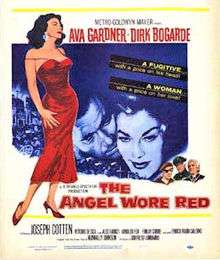The Angel Wore Red
| The Angel Wore Red | |
|---|---|
 Theatrical release poster | |
| Directed by | Nunnally Johnson |
| Produced by | Goffredo Lombardo |
| Written by |
Nunnally Johnson Bruce Marshall (novel) |
| Starring |
Ava Gardner Dirk Bogarde Joseph Cotten Vittorio De Sica Aldo Fabrizi Enrico Maria Salerno |
| Music by |
Bronislau Kaper Angelo Francesco Lavagnino |
| Cinematography | Giuseppe Rotunno |
| Distributed by |
Metro-Goldwyn-Mayer Titanus |
Release dates | September 28, 1960 |
Running time |
Italy: 95 min USA: 99 min |
| Country |
United States Italy |
| Language |
English Italian |
| Budget | $1,843,000[1] |
| Box office | $935,000[1] |
The Angel Wore Red, also known as La Sposa Bella in its Italian version, is a 1960 Italian-American romantic war drama starring Ava Gardner and Dirk Bogarde made by MGM and Titanus. It was directed by Nunnally Johnson and produced by Goffredo Lombardo, from a screenplay by Johnson based on the 1953 novel The Fair Bride by Bruce Marshall.
Giorgio Prosperi wrote the dialogue for the Italian version. The music score for the American version was by Bronislau Kaper and by Angelo Francesco Lavagnino for the Italian version. The cinematography was by Giuseppe Rotunno.[2][3][4][5]
Plot
Young Catholic priest Arturo Carrera (Bogarde) sympathizes with the poor in the Spanish Civil War, but finds that his fellow priests have little concern for the poor, because they support the Nationalist rebels. He then resigns from the priesthood. Hours later, the city is bombarded and he takes shelter with a mysterious beautiful woman named Soledad (Gardner).
They part. As night falls, Loyalist speakers induce a mob to torch the church, whose ranking cleric moves to hide the Blood of St John relic by giving his deputy the task of taking it to Franco's Nationalists. Both the deputy and Arturo become hunted men. Arturo seeks shelter in a local cabaret, where he again meets the mystery woman, who turns out to be a prostitute.
Soledad discovers that Arturo was a priest, but because she likes him, she tries unsuccessfully to hide him from the militiamen. Hawthorne, a habitué of the bar and a New York war correspondent (Joseph Cotten) with a platonic relationship with her, does his best to free Arturo. Arturo tells the Loyalist intelligence chief he can make himself useful by comforting Catholic Loyalists who are wavering because of the treatment of the Church.
Out of jail, but under surveillance, Arturo meets Soledad and the priest who has hidden the holy relic. The absence of the relic is causing unrest in the town and unsettling the local Loyalist militia, now suffering massive desertions because of the missing relic, which is fabled to provide victory to those who possess it. This makes it essential for the local Loyalists to secure it. But because of a well-meaning, disastrous attempt to feed the old priest in hiding, Soledad leads Loyalist security men to his hideout.
Despite torture, the old priest refuses to give up the relic's location, and is to be shot at dawn. The security chief then has Arturo hear the condemned priest's confession. Learning of the relic's whereabouts, Arturo takes it, but claims not to know where it is. But he is then arrested and taken to see the torturing of Soledad, for whom he has declared his love.
Soledad is spared by the arrival of the commanding general, an old man who disapproves of torture and dirty tricks. He orders all 250 prisoners to be marched out to the battle lines. There they will be given arms to slowing the Nationalist advance on the city and cover the Loyalists' retreat. On the march, Arturo gives Soledad the relic so she can try to take it to safety. However, in a surprise nighttime rebel attack, she is seriously wounded. The prisoners change hands, but the Nationalist commander decides he cannot trust them or leave them behind; he orders that they be executed. Arturo pleads with the officer assigned the task, but the man does not believe Arturo's story. Before more than a few unfortunates have been shot, however, Soledad and the relic are found. She dies, but the prisoners are set free.
Cast
- Ava Gardner – Soledad
- Dirk Bogarde – Arturo Carrera
- Joseph Cotten – Hawthorne
- Vittorio De Sica – General Clave
- Aldo Fabrizi – Canon Rota
- Arnoldo Foà – Insurgent major
- Finlay Currie – Bishop
- Rossana Rory – Mercedes
- Enrico Maria Salerno – Captain Botargus
- Robert Bright – Father Idlefonso
- Franco Castellani – Jose
- Bob Cunningham – Mac
- Gustavo De Nardo – Major Garcia
- Nino Castelnuovo – Captain Trinidad
- Aldo Pini – Chaplain
Box Office
According to MGM records the film earned $410,000 in the US and Canada and $525,000 elsewhere, resulting in a loss of $1,527,000 – one of MGM's biggest flops of the year.[1]
References
- 1 2 3 The Eddie Mannix Ledger, Los Angeles: Margaret Herrick Library, Center for Motion Picture Study.
- ↑ "The Angel Wore Red (1960)". imdb.com. Retrieved 30 November 2013.
- ↑ Arnold, Jeremy. "The Angel Wore Red". tcm.com. Retrieved 30 November 2013.
- ↑ ARCHER, EUGENE. "The Angel Wore Red (1960)". nytimes.com. Retrieved 30 November 2013.
- ↑ "The Angel Wore Red". mubi.com. Retrieved 30 November 2013.
